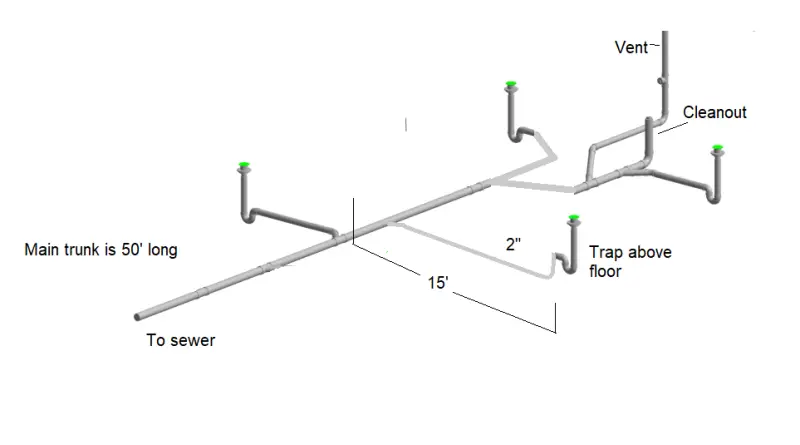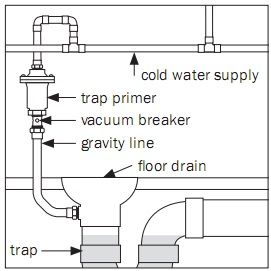What Is A Trap Primer?
Why do you need to know what a trap primer is…or for that matter, what a trap is? Because homes, plumbing systems, electric systems, and even the ground can do weird things. Such as emitting a rotten odor you can’t ignore.
When that happens, it’s quite possibly due to sewer gas coming into your home from your floor drain. To keep that gas out, your drain requires a trap, and that trap needs a trap primer.
What is a trap Primer
A trap primer is a device used in plumbing systems to maintain water seals in traps that may otherwise dry out over time. Traps are plumbing components designed to prevent sewer gases from entering buildings by creating a water seal. However, these water seals can evaporate or be depleted over time, especially in infrequently used drains or floor drains.
The trap primer is typically connected to the water supply line and releases a small amount of water periodically into the trap, ensuring that the water seal is maintained. This helps prevent the escape of sewer gases into the building and ensures that the trap functions effectively. Trap primers are commonly used in commercial and industrial buildings where certain floor drains or fixtures may not receive regular use.
There are different types of trap primers, including automatic devices and manually operated ones. The choice of trap primer depends on the specific plumbing system requirements and local building codes.
What Does A Plumbing Trap Look Like?
Let’s discuss the trap first. A plumbing trap looks like a U-shaped pipe. This U-shaped pipe also looks like the letter P on its side. That’s why plumbers call it a P Trap. It can be made out of metal or PVC (a synthetic plastic polymer which has a white-plastic look). Take a look under your kitchen sink or bathroom sink to see one for yourself.
How Does a Plumbing Trap Work?
All plumbing fixtures in a home have floor drains. The floor drains allow water to flow from your house and into a city’s sewer or storm drains. This keeps your floors dry and safe from water damage.
More so, each plumbing fixture — from kitchen sinks to toilets to showers to water heaters and more — is required to have a plumbing trap. The traps stop smelly sewer gases from coming up from the floor drain and into your home. However, in order for these plumbing traps to work — by “trapping out the sewer gas emissions” — water needs to drain into them to create a liquid seal.
Put another way, here’s what’s happening. Water is trapped at the bottom of the U-shaped P Trap. This trapped water creates a seal in your pipe, which prevents any sewer gas from coming up through the drain and into your home. Sewer gas can’t get past the seal of water at the bottom of the U-shaped trap. It’s a simple but brilliant solution.
What Is A Trap Primer And Why Do We Need It?
Just like the trap, a trap primer is relatively simple to understand. It’s a device that adds water to your plumbing trap. That’s it. And here’s why you need it.
If liquid doesn’t go down your drain often enough, the liquid seal – the water at the bottom of the U-shaped trap — will eventually evaporate. With the seal gone, sewer gas is now able to get through the drain pipe and into your home. That’s a serious problem, and can lead to a plumbing emergency (or even a health emergency; scroll down for more on that).
A trap primer (or trap primer valve) is a good idea for all of your plumbing fixtures. But don’t hesitate installing them on any plumbing fixtures that aren’t being used regularly. This could be an extra bathroom sink, shower and toilet; or perhaps in a vacation home you only visit once or twice a year.
Different Types of Trap Primers
- Most simple method. Used most often with a floor drain trap is a quick connection from a sink that’s closely located. When the sink is used, some of the water goes to the trap.
- Most common method. The primer connects to a drinkable water supply. When pressure per square inch (PSI) is sensed — such as from a nearby toilet or sink — it adds some of that water flow to the trap.
- Other methods. Some trap primers work on timers (based on your settings for when a home is unoccupied). While others create plumbing devices (like a laundry faucet) has has a built-in trap primer. And there are other types as well.
Floor Drain Trap Guard
A floor drain trap guard is a device designed to prevent unwanted debris, solids, or objects from entering and potentially clogging the trap of a floor drain. Floor drains are common in various settings, such as commercial kitchens, industrial facilities, basements, and other areas where liquids may need to be drained away. The trap is a crucial component of a floor drain, creating a water seal that prevents sewer gases from entering the building.
The trap guard is installed within or over the opening of the floor drain and serves as a barrier to large particles, preventing them from entering and obstructing the trap. This helps maintain the proper functioning of the drainage system and reduces the risk of blockages that could lead to foul odors or potential backups.
Trap guards come in various designs, including grates with built-in screens or separate devices that can be added to existing drains. They are typically removable for easy cleaning and maintenance. The specific type of trap guard used may depend on the size and type of debris that needs to be blocked, as well as the requirements of the particular drainage system.
Floor Drain Plumbing Diagram

A floor drain plumbing diagram typically includes a trap, which prevents sewer gases from entering a building. The left side of the trap connects to the plumbing fixture, and the right side connects to the sewer. When a floor drain is clogged, it can be due to issues in the trap itself or downstream from the drain. To differentiate, removing the cleanout plug can help diagnose the problem. If water drains properly after removing the plug, the trap may need cleaning with a drain auger. If water still doesn’t drain, the issue may be downstream from the trap.
The house drainage system consists of various components like branch drain lines, soil pipes, soil stack vents, drain traps (P-traps), toilet traps, and main drain lines. The P-trap is a crucial component found below plumbing fixtures like sinks and bathtubs, designed to hold standing water to prevent sewer gases from entering a home.

Is Sewer Gas Harmful?
Sewer gas is not usually harmful in smaller doses. But sewer gas can be harmful over time, with prolonged, heavier doses, if the problem isn’t resolved. The primary gas in sewer gas is hydrogen sulfide. More so, studies have shown that large amounts are toxic to our oxygen systems, with the potential to damage organs and, in rarer circumstances, even cause death.
If you notice that there is an unpleasant odor coming from areas of your home where there are floor drains, you may want to check to make sure you don’t have a dry trap and do have a functioning trap primer.
Final Thoughts
In conclusion, trap primers are very important in your home. They prevent your p-traps from becoming dry so sewage gases have no way of leaking into your home. This can be especially helpful if you own a vacation home that you only visit around once or twice a year.
